
William Herschel discovered NGC 3432 = H I-172 = h780 on 19 Mar 1787 (sweep 719) and recorded "cB, about 2' long and 1/2' broad from sp to nf. In the preceding part a few stars pretty close together, and in the following part one, but unconnected." His position matches UGC 5986.
On 11 Mar 1831 (sweep 331), John Herschel recorded, "pB; vmE; 90" l, 12" br; pos = 44.2° It southern extremity touches the large star of a double star [at the south end]. Can this nebula have moved?" On 7 Feb 1832 (sweep 401), he logged "vF; a long ray pos = 40.8°; has a double star class 4 in middle, and one more." But the star at the east edge of the middle is only single. Rudolph Spitaler measured the position of a knot or HII region at the northeast end in an observation at Vienna in 1891.
Friedrich Bidschof measured two micrometric positions at the Vienna Observatory in Feb 1892 - one for the center or core and a second at a knot (HII complex) I mentioned in my notes.
400/500mm - 17.5" (3/25/95): fairly bright, large, edge-on 6:1 SW-NE, 3'x0.5. Irregular surface brightness and fainter on the southwest end. Appears to have a sharper light cut-off on the north side (due to dust?). A mag 12.5 star is 48" E of center and two mag 12/13 star are very close to the southwest tip 1.4' from center. The galaxy appeared asymmetric and brightest just north of the mag 12.5 star near the core [this corresponds to an HII complex]. A very weak enhancement [this is the core] is close west-southwest of this star.
Notes by Steve Gottlieb